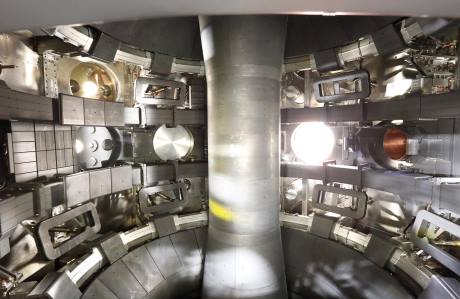The UK Atomic Energy Authority (UKAEA) has welcomed the government's investment of GBP86 million that will fund the building and operation of a National Fusion Technology Platform (NaFTeP) at Culham Science Centre, which is expected to open in 2020. The Department for Business, Energy and Industrial Strategy announced the new funding as part of a series of measures that aim to support the development of 'next-generation nuclear technology', which follows publication of the government's Industrial Strategy white paper last month.
 |
| A view inside UKAEA's MAST (Mega Amp Spherical Tokamak) fusion research device (Image: UKAEA) |
UKAEA said the new facilities will support British industry and help to secure around GBP1 billion in contracts from the key international fusion research experiment ITER, now being built in France, and other global fusion projects. Looking further ahead, it added, the facilities will enable UKAEA to develop technology for the first nuclear fusion power plants and put UK industry in a strong position to exploit the commercialisation of this highly promising low-carbon energy source.
Ian Chapman, CEO of UKAEA, said: "Fusion is entering the delivery era, with an increasing focus on the key technologies that will be needed for the first power stations. The National Fusion Technology Platform will help British industry to maximise growth from opportunities provided by ITER. In the longer term it means the UK will be at the forefront of developing fusion and bringing cleaner energy to the world."
NaFTeP comprises two new centres of excellence: Hydrogen-3 Advanced Technology (H3AT), which will research how to process and store tritium, one of the fuels that will power commercial fusion reactors; and Fusion Technology Facilities (FTF), which will carry out thermal, mechanical, hydraulic and electromagnetic tests on prototype components under the conditions experienced inside fusion reactors.
"[NaFTeP] will enhance the UK's expertise in critical areas of fusion research, with significant benefits to the economy as part of the government's Industrial Strategy. It will also provide a powerful signal of the UK's intent to continue its participation in international science collaboration after leaving the European Union," UKAEA said.
So far, 38 UK companies have won contracts totalling more than EUR500 million on the EUR14 billion ITER experiment, which UKAEA said is "the stepping stone to fusion power stations".
H3AT and FTF will work closely with the industrial supply chain to create knowledge to position them for the next phase of ITER procurements in areas including the tritium plant, Hot Cell, measurement systems, assembly, maintenance and reactor materials, it said. NaFTeP is expected to create around 100 jobs at Culham Science Centre and many more in the wider nuclear industry supply chain, it added.
Researched and written
by World Nuclear News





_18570.jpg)
_16159.jpg)
_49205.jpg)





